This whole wheat puff pastry dough recipe is almost identical to a classic puff pastry, but takes half the time to make and gets a flavor boost from nutty whole wheat flour. Delicious in turnovers, on pot pie, or tarte tatin.
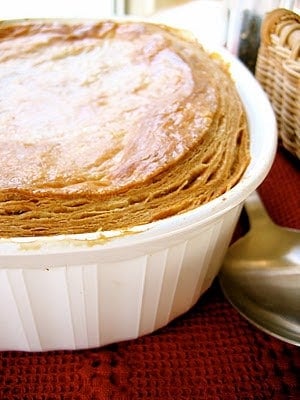
I loved learning how to make laminated doughs and other flaky pastries in pastry school. Nothing was more magical than watching homemade puff pastry dough rise into tall, handsome layers in the oven.
Today I'm sharing my recipe for quick whole-wheat puff pastry. This method takes half the time of traditional puff pastry, but it still bakes up with tons of flaky layers. Whole wheat flour adds nutritional value and rich, earthy flavor.
Read on for the method and step-by-step photos!
If you love lamination as much as I do, here are a few other recipes that use this same technique:
- Flaky Goat Cheese Biscuits
- Homemade Chocolate Croissants
- Extra-Flaky Pie Crust Dough
- Gluten-Free Pie Crust Dough
- Paleo Almond Flour Pie Crust
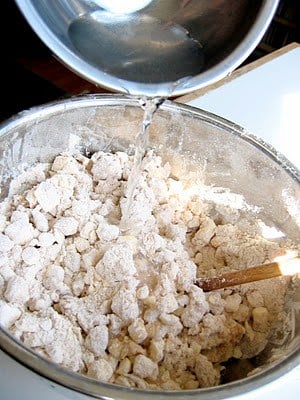 |
| Adding ice water and lemon juice to the flour/butter mixture |
Laminated Doughs – Traditional Method
The classic technique for making puff pastry and croissant dough involves making a lean dough of flour, ice water, salt, and sugar (and yeast in the case of croissants), and then forming a block or slab of butter which you fold into the lean dough.
The dough gets folded up like a letter and rolled out repeatedly, chilling for an hour between turns, making dozens of ultra-thin layers of butter and dough.
When the dough hits the heat of the oven, the butter (which is 15% water), lets off steam, raising the layer of dough above it. The finished product's many layers flake and shatter.
Despite all that butter, a well-laminated and baked dough should taste light on the palate, rather than heavy or greasy.
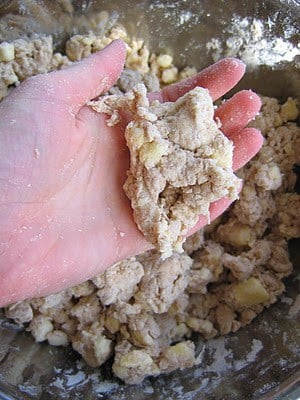 |
| The dough clumping together when squeezed |
Quick Puff Pastry Method
I've adapted Cook's Illustrated streamlined the process for making this quick whole-wheat puff pastry. This uses the simpler method of:
- cutting butter chunks into the dough (similar to making pie crust)
- fraisage-ing the dough (scraping portions of dough across the work surface with the palm of your hand)
- then folding and rolling the dough several times in a row, without chilling between every turn (similar to traditional lamination but so much faster!)
The finished dough is almost identical to a classic puff pastry, but takes about half the time to make (3 hours as opposed to 6).
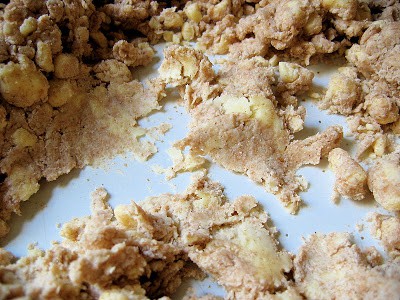 |
| The dough, mid-fraisage |
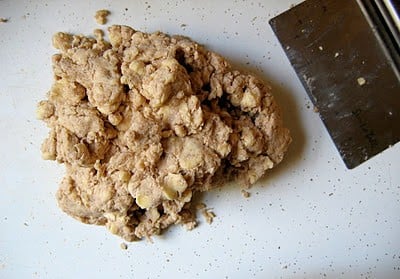 |
| and post-fraisage |
I add a bit of whole wheat bread flour to the dough because I like the flavor it adds, but feel free to use all white flour if you prefer; an all-white dough will have slightly more loft.
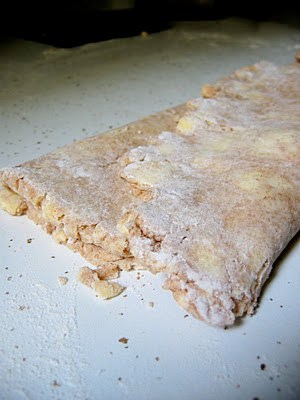 |
| Fold #1 |
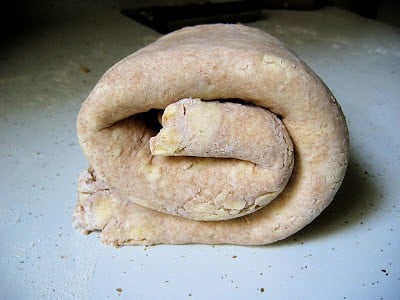 |
| and roll #1 |
Puff pastry has many uses: tuck apples and quince inside for some stellar turnovers, cut it into strips and sprinkle with parmesan for cheese straws, roll it up with sugar for palmiers, or lay them over a vegetable stew thickened with bechamel for pot pie.
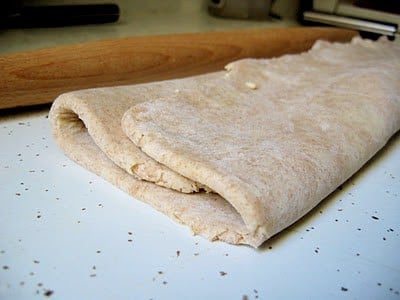 |
| Fold #2 - a smoother dough |
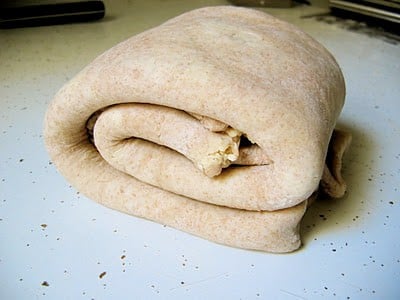 |
| and roll #2 |
I always find making puff pastry to be a magical experience; one of those things that goes into the oven looking unremarkable and emerges transformed into something magnificent.
If only I could make my croissants look good, too...
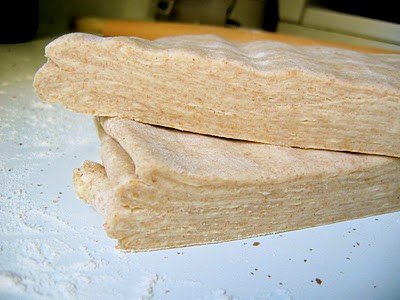 |
| The finished dough and its many layers |
*Bojon appétit! For more Bojon Gourmet in your life, follow along on Instagram, Facebook, or Pinterest, purchase my gluten-free cookbook Alternative Baker, or subscribe to receive new posts via email. And if you make this whole wheat puff pastry recipe, I’d love to know. Leave a comment and rating below, and tag your Instagram snaps @The_Bojon_Gourmet and #bojongourmet.*
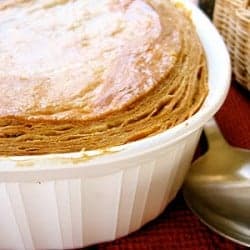
How to Make Quick Whole Wheat Puff Pastry
Print Recipe Pin RecipeIngredients
- 1 ½ cups all-purpose flour (about 180 g)
- 1 ½ cups whole wheat bread flour (about 180 g)
- 1 ½ tablespoons sugar
- 1 ½ teaspoons salt
- 12 ounces cold, unsalted butter, cut into 1/4" cubes and chilled again until firm (3 sticks/ 1 1/2 cups)
- 9 tablespoons ice water
- 2 teaspoons lemon juice
Instructions
- Combine the flours, sugar and salt in the bowl of a food processor, pulsing once to combine. Add 1/4 of the butter chunks and pulse 4 times until the dough is in dime-sized pieces. Add the remaining butter and process 2 times just to coat the butter cubes with flour. Transfer the mixture to a large bowl.
- Combine the ice water and lemon juice in a small bowl. Drizzle half of the liquid over the flour/butter mixture and toss with a rubber spatula until just combined. Add more liquid, 1 tablespoon at a time, until the dough clumps together when squeezed.
- Turn the dough - which will be very shaggy - out onto your work surface. Fraisage the dough by dragging small portions of it across the counter under the heel of your hand (see photo in post above). The motions should be quick and brisk so that the butter stays as cold as possible. This action creates many thin layers of dough and butter, and begins to bring the dough together.
- Gather the dough up into a ball (a metal pastry scraper is helpful here), press it into a disc, wrap it in plastic and chill it for 1 hour.
- Remove the chilled dough from the fridge, unwrap it, and place it on a lightly floured surface. Dust the dough lightly with flour, sweep off any excess with a pastry brush, and roll out the dough to a 15x10" rectangle. Fold the dough lengthwise into thirds, like folding a letter, then, starting from a short end, loosely roll up the dough into a spiral. (See photos in post, above.)
- If the dough is sticky or springy at this point, wrap it in plastic and chill it for 30 minutes.
- Press down on the dough to form a small rectangle, and again roll it out into a 15x10" rectangle, and again roll it up into a spiral. Flatten it out a bit to make it easier to roll once it has chilled. Wrap the dough in plastic and chill for at least 1 hour.
- Your puff pastry is now ready to be used. You can store it in the fridge for a day or two, or freeze it, double-wrapped, for many months.


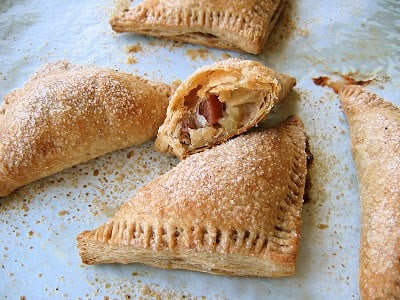
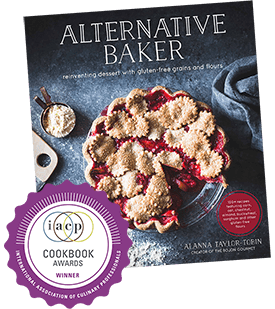

Amanda says
Hi there! I was wondering if I could replace the sugar with honey as we do not eat refined sugar! Thanks so much!
Alanna says
Not sure... I might try an unrefined dry sugar (such as maple, date, coconut, etc) to be safe.
Eric C says
Hi there. I am wondering if it is possible to use the gluten-free pie crust flour from your alternative baker cookbook for this method to try to make puff pastry? That crust already seems to get some great layers, and maybe it might be possible to get more from that dough but this method?
Alanna says
Hi Eric, That's a genius idea! Let me know if you try it and I'll do the same. :)
Eric C says
I will try it today! Already in the process of making the dough, using your GF pie crust recipe. I'll be sure to let you know how it went.
Eliza says
Hi just wondering if the sugar is necessary, or if it is just for taste? Thanks!!
Alanna says
Mostly for taste, though it helps with browning a little. If you try it without, please report back! :)
Eliza says
Thanks for the answer :) I tried without the sugar and the pastry was still delicious! I used a egg/milk glaze so browning wasn't an issue
Alicia says
Can I use a plant based butter instead?
Alanna Taylor-Tobin says
I haven't tried it but I think that should work! Please let me know how it goes :)
Lulu says
I'd love to know the weight measurements for this recipe.
Alanna Taylor-Tobin says
Hi Lulu,
I went ahead and added weight measurements for the flours. Please let me know if you try it!
-Alanna
M says
Is it possible to use all wholewheat instead of half white?
Alanna Taylor-Tobin says
That's a great question. I'm guessing the pastry will be more dense and it might feel a little heavy or oily, but it would probably still be buttery, flaky, and delicious. Please let me know if you try making it with all whole wheat flour!